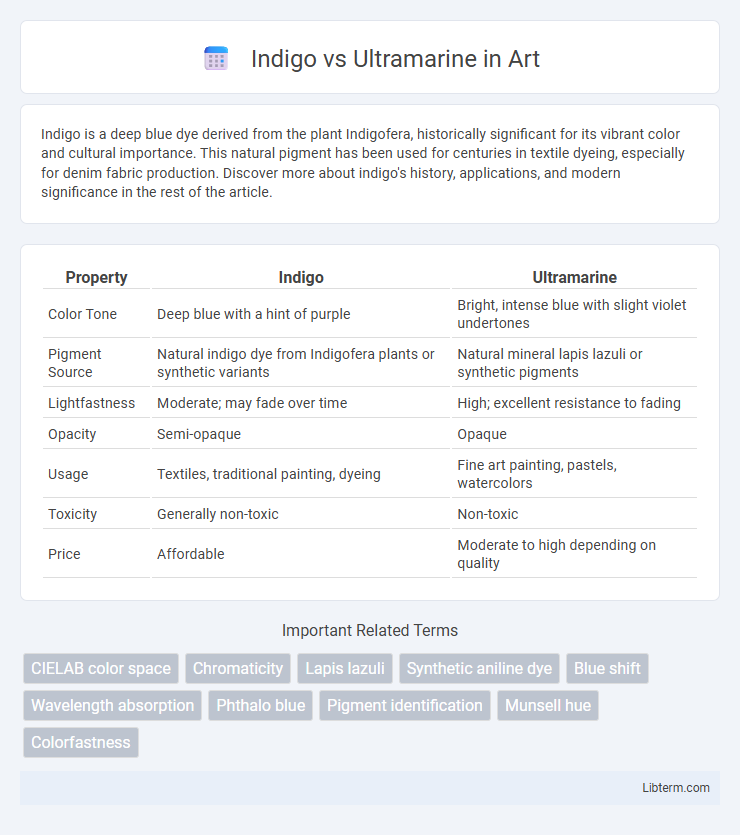Indigo is a deep blue dye derived from the plant Indigofera, historically significant for its vibrant color and cultural importance. This natural pigment has been used for centuries in textile dyeing, especially for denim fabric production. Discover more about indigo's history, applications, and modern significance in the rest of the article.
Table of Comparison
| Property | Indigo | Ultramarine |
|---|---|---|
| Color Tone | Deep blue with a hint of purple | Bright, intense blue with slight violet undertones |
| Pigment Source | Natural indigo dye from Indigofera plants or synthetic variants | Natural mineral lapis lazuli or synthetic pigments |
| Lightfastness | Moderate; may fade over time | High; excellent resistance to fading |
| Opacity | Semi-opaque | Opaque |
| Usage | Textiles, traditional painting, dyeing | Fine art painting, pastels, watercolors |
| Toxicity | Generally non-toxic | Non-toxic |
| Price | Affordable | Moderate to high depending on quality |
Introduction to Indigo and Ultramarine
Indigo is a deep blue dye derived from the plant Indigofera tinctoria, historically used in textile coloring and known for its rich, saturated hue. Ultramarine, a vivid blue pigment made from the mineral lapis lazuli, gained prominence in Renaissance art for its intense color and durability. Both indigo and ultramarine have distinct chemical compositions and historical significance in art and dye industries.
Historical Origins and Discovery
Indigo, derived from the Indigofera plant, has been cultivated and used as a dye since ancient times in India, dating back over 4,000 years. Ultramarine originates from the semi-precious stone lapis lazuli, mined primarily in the Badakhshan region of Afghanistan since the 6th century BCE. The discovery of ultramarine as a pigment revolutionized art in the Renaissance, whereas indigo's extensive trade established it as a significant economic commodity in the colonial era.
Chemical Composition and Production
Indigo is primarily composed of indigotin (C16H10N2O2), derived from plants like Indigofera tinctoria or synthesized from aniline through complex chemical reactions. Ultramarine is a sodium aluminosilicate containing sulfur, with the formula Na8-10Al6Si6O24S2-4, produced by heating a mixture of kaolin, sodium carbonate, sulfur, and charcoal at high temperatures. The chemical synthesis of ultramarine involves a calcination process, whereas indigo production relies on both natural extraction and organic synthesis methods.
Color Characteristics and Visual Differences
Indigo displays a deep blue hue with subtle hints of violet, creating a rich, intense color often associated with dusk and twilight. Ultramarine features a brighter blue with a slight reddish undertone, giving it a more vibrant and luminous appearance compared to indigo's muted depth. The visual difference is apparent in their light-reflecting qualities--indigo absorbs more light, resulting in a darker shade, while ultramarine's higher luminosity enhances its vividness and versatility in artistic applications.
Uses in Art and Paintings
Indigo and Ultramarine are both prized pigments in art for their distinct blue hues and versatility. Ultramarine, derived from the semi-precious stone lapis lazuli, is favored for its bright, intense blue often used in Renaissance and Baroque paintings to depict skies and robes. Indigo, a natural dye extracted from plants, offers a deeper, muted blue ideal for fabric painting and traditional dyeing techniques, giving artworks a rich, earthy tone.
Performance in Various Mediums
Indigo and Ultramarine pigments exhibit distinct performance characteristics across different artistic mediums. Indigo tends to provide deep, rich blues with excellent lightfastness in oil and acrylic paints but can appear more muted in watercolors due to its lower tinting strength. Ultramarine offers vibrant, intense blue hues with high transparency and granulation, performing exceptionally well in watercolors and maintaining stability and brilliance in oils and acrylics.
Lightfastness and Durability
Indigo exhibits moderate lightfastness, making it somewhat prone to fading when exposed to prolonged sunlight, while Ultramarine offers superior lightfastness with high resistance to fading over time. In terms of durability, Ultramarine is more chemically stable and maintains its vibrancy in various environmental conditions, whereas Indigo tends to degrade faster due to its organic composition. Artists and designers seeking long-lasting pigment performance often prefer Ultramarine for projects requiring exceptional color retention and resilience.
Cost and Availability
Indigo pigment is generally more expensive due to limited natural sources and complex synthetic production, while ultramarine offers a affordable option with wide availability because it is synthetically produced on a large scale. Ultramarine's consistent quality and lower price make it a popular choice for artists and industrial applications. Cost-efficient ultramarine is readily stocked by most art supply stores, whereas indigo may require specialty vendors or higher purchase quantities.
Environmental Impact and Safety
Indigo and ultramarine pigments differ significantly in their environmental impact and safety profiles; indigo, derived traditionally from plant sources, is biodegradable and poses minimal toxicity risks, making it eco-friendly. Ultramarine, a synthetic pigment made from sodium aluminosilicate and sulfur, involves energy-intensive manufacturing and can release sulfur compounds, potentially impacting air quality if not managed properly. Both pigments require careful handling to minimize environmental footprint, but indigo's natural origin generally offers a safer option for sustainable art and textile applications.
Choosing Between Indigo and Ultramarine
Choosing between indigo and ultramarine depends on the desired hue and application; indigo offers a deep, rich blue with hints of violet, while ultramarine provides a vibrant, intense blue with slight warmth. Artists and designers favor ultramarine for its brightness and excellent lightfastness, making it ideal for fine art and digital media. Indigo's muted tone suits fashion and textiles seeking a classic, sophisticated look with subtle color variation.
Indigo Infographic

 libterm.com
libterm.com